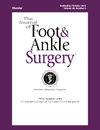Distal tibial osteophytes are more accurate than medial malleolar anatomy when using patient specific instrumentation in total ankle replacement
IF 1.3
4区 医学
Q2 Medicine
引用次数: 0
Abstract
Total ankle replacement (TAR) is a treatment for end stage ankle arthritis. Patient specific instrumentation (PSI) has been used and shown to allow for accurate placement and alignment in TAR in the coronal and sagittal plane. PSI systems are available and use different anatomic landmarks for the cutting guides. This is a retrospective matched case control study comparing accuracy in alignment using 2 different PSI systems. The case series uses a medial malleolar landmark (MM Group), and each case patient was matched based on preoperative coronal plane alignment with 2 ankles in the control series using the distal tibial osteophytes as landmarks (DT Group), as this system has been in use and studied more. A total of 48 ankles were studied, 16 in the MM Group and 32 in the DT Group matched by coronal plane alignment. There was a difference in accuracy of postoperative coronal plane alignment, with the MM Group deviated from expected by 1.6° ± 1.3° compared to the DT Group at 1.1° ± 0.6°, p = 0.04. This corresponded to 68.8 % of MM Group ankles being within 2° of expected compared to 93.4 % of DT Group ankles. There was no statistically significant difference in sagittal plane alignment between the groups, p = 0.57. Procedure time was the only other statistically significant difference with the MM Group taking longer than the DT Group, 97.4 min and 80.6 min, respectively, p = 0.04. While both groups show good accuracy, alignment based on the distal tibial osteophytes is more accurate than using the medial malleolus.
在全踝关节置换术中使用患者专用内固定时,胫骨远端骨赘比内踝解剖更准确。
全踝关节置换术(TAR)是治疗终末期踝关节关节炎的一种方法。患者专用内固定(PSI)已被使用并被证明可以在冠状面和矢状面对TAR进行准确的定位和对齐。PSI系统是可用的,并使用不同的解剖标志的切割导轨。这是一项回顾性匹配病例对照研究,比较使用2种不同PSI系统的对准精度。病例系列使用内踝标志(MM组),每个病例患者根据术前冠状面对准对照系列中的2个踝关节进行匹配,以胫骨远端骨赘为标志(DT组),因为该系统的使用和研究更多。共研究48个踝关节,MM组16个,冠状面对齐DT组32个。术后冠状面对准精度存在差异,MM组与DT组相比偏差1.6°±1.3°,相差1.1°±0.6°,p=0.04。这相当于68.8%的MM组踝关节偏离预期2°,而DT组的这一比例为93.4%。两组间矢状面排列差异无统计学意义,p=0.57。手术时间是MM组比DT组长,分别为97.4分钟和80.6分钟,p=0.04。虽然两组都显示出良好的准确性,但基于胫骨远端骨赘的对准比使用内踝的对准更准确。临床证据等级:3,回顾性匹配病例对照研究。
本文章由计算机程序翻译,如有差异,请以英文原文为准。
求助全文
约1分钟内获得全文
求助全文
来源期刊

Journal of Foot & Ankle Surgery
ORTHOPEDICS-SURGERY
CiteScore
2.30
自引率
7.70%
发文量
234
审稿时长
29.8 weeks
期刊介绍:
The Journal of Foot & Ankle Surgery is the leading source for original, clinically-focused articles on the surgical and medical management of the foot and ankle. Each bi-monthly, peer-reviewed issue addresses relevant topics to the profession, such as: adult reconstruction of the forefoot; adult reconstruction of the hindfoot and ankle; diabetes; medicine/rheumatology; pediatrics; research; sports medicine; trauma; and tumors.
 求助内容:
求助内容: 应助结果提醒方式:
应助结果提醒方式:


